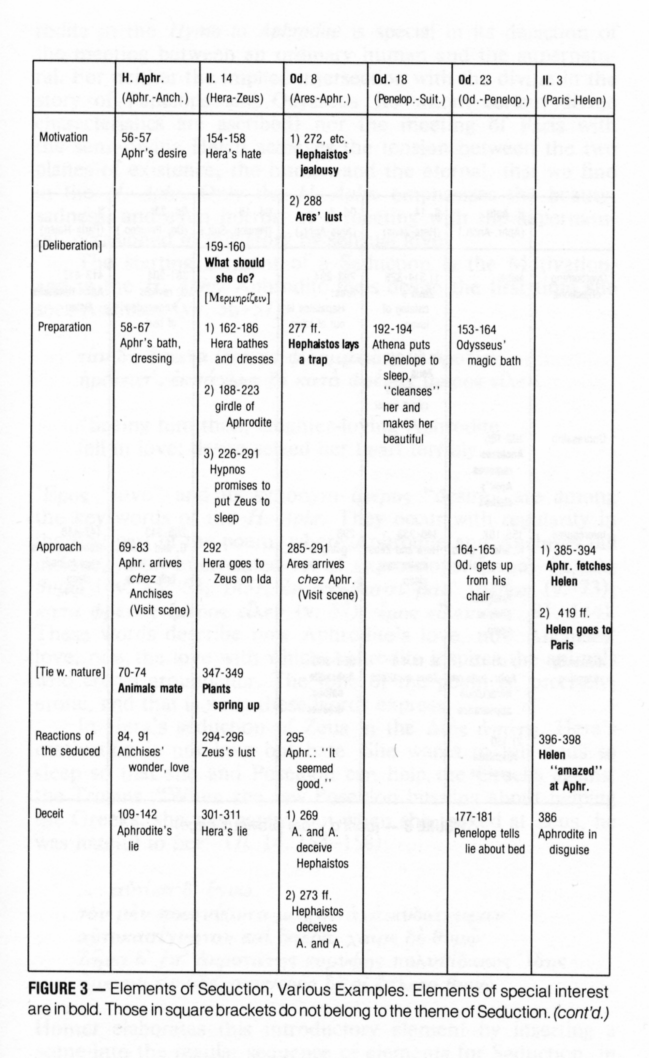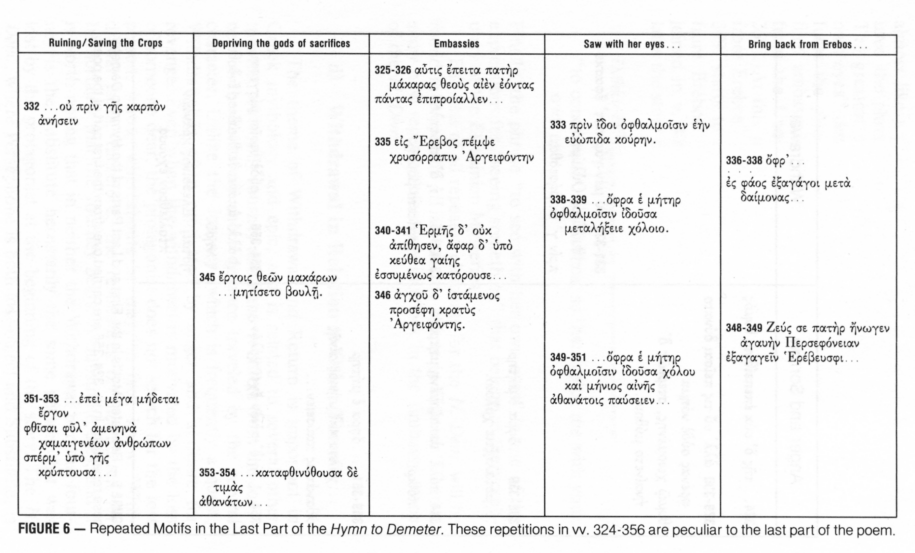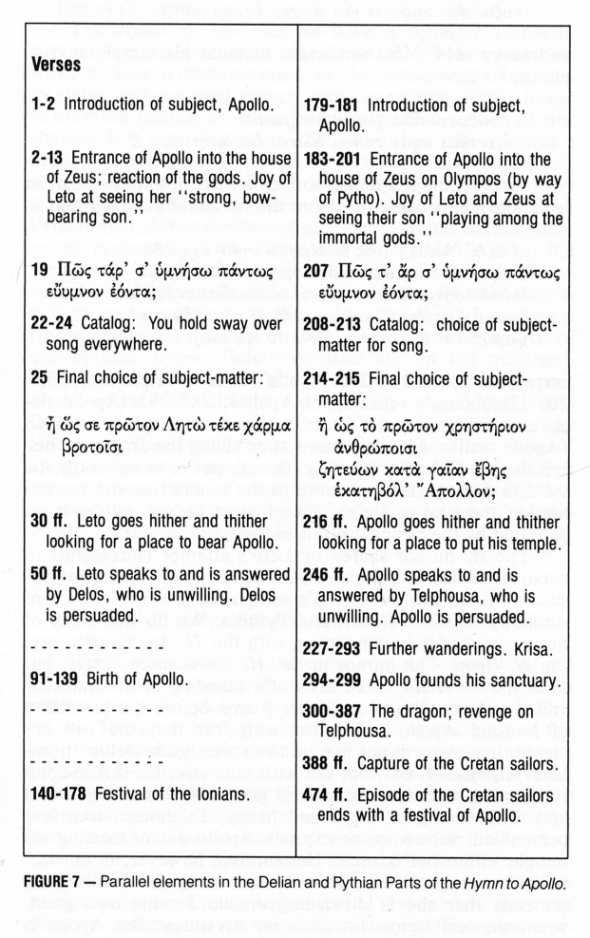Traditional Themes and the Homeric Hymns
by Dr. Cora Angier Sowa
Appendix I: Outlines of Themes Identified in the Hymns, plus diagrams from various chapters

|

|
Remarks on the Web version:Chapters 1 "Introduction" and 10 "Conclusion" of my Traditional Themes and the Homeric Hymns (Mundelein, IL: Bolchazy-Carducci, 1984), as well as Appendix I and some of the diagrams that outline the thematic structure of the Hymns, are presented on this Web site for free reading. The entire book (including the other eight chapters, "The Marriage of the Fertility Goddess," "Seduction," "The Withdrawal and Return of the Hero," "Rape" (including "The Maiden Abducted While Dancing and Picking Flowers"), "The Young God Consolidates His Power," "Invention and Trickery," "The Journey," and "Epiphany of a God and Institution of Rites") is now again available from Bolchazy-Carducci by on-demand printing; readers may contact the publisher for more information. For this Internet version, Greek words and passages, rendered in their normal Greek alphabet in the printed book, are transliterated. In addition, English translations have been added, which were not in the original. These additions are indicated by brackets, thus: Rheiês êükomou thugatêr ["daughter of beautiful-haired Rheia"]. The text was scanned from the printed book and turned into machine-readable text by using a product called TextBridge® from ScanSoft. The results always require at least some editing, and I apologize if any typographical errors have crept back in. The page numbers that are shown are those of the original printed edition. Three of my papers that are referenced in the book, "Verbal Patterns in Hesiod's Theogony", "Thought Clusters in Early Greek Oral Poetry" (with John F. Sowa), and "Ancient Myths in Modern Movies", are also on this Web site. |
Page 281
Appendix I: Outlines of Themes Identified in the Hymns |
The outlines in Appendix I summarize the principal themes discussed in the chapters making up the body of the book. Appendix II contains line-by-line analyses of the four major Hymns (although the book itself is not limited to these four poems) in terms of the thematic elements shown in these outlines. Two of the themes, "Maiden Abducted While Dancing and Picking Flowers" and "The God Welcomed by Maidens," are subtypes of major themes, namely Rape and Epiphany, but their importance is such that they are analyzed separately, especially since they include significant elements not found in other forms of the themes. "Exchange of Gifts" is properly a type scene (a short recurring "paragraph" that reappears virtually unchanged in many poems), but it, too, has a special importance, since it forms the framework for a significantly long portion of the Hymn to Hermes. One of the factors making the traditional themes appear different in various poems is their incorporation of the vocabulary peculiar to a particular poem or poet. Appendix III lists some of the most important repeated groups of words for each of the four major Hymns. Many of these word groupings were called to my attention by work done with the computer, reported in "Thought Clusters in Early Greek Oral Poetry."
I. The Marriage of the Fertility Goddess:
- Zeus causes the goddess to become involved with mortals.
- Goddess appears to mortals in disguise.
2a. Goddess tells lie. - Goddess reveals her identity to mortals.
- Goddess would like to give immortality to mortal,
4a. but gives fertility or equivalent instead.
II. Seduction:
- Motivation--the emotion felt by the seducer, causing him or her to undertake the seduction.
- Preparation. This often includes bathing and dressing.
- The seducer goes to the seduced.
Page 282
- The reaction of the seduced.
- The seducer must overcome the objections of the seduced.
- Deceit (this may be part of 5., but not necessarily).
- They make love.
7a. They go to bed.
7b. They have intercourse.
7c. They go to sleep. - They get up again and get dressed.
III. The Withdrawal and Return of the Hero:
- Loss is caused to the protagonist.
- Protagonist withdraws angrily.
2a. Announcement of withdrawal.
2b. Prayer for vengeance.
2c. Conditions for return are stated.
2d. Withdrawal causes great loss to the community. - Embassies.
3a. Embassies are sent vainly to the protagonist.
3b. Successful embassy or other device for getting the protagonist to return. - Protagonist finally returns.
4a. Return causes victory or increase for the community. - Death of the Substitute.
IV. Rape:
- Abduction of a divine or semi-divine or human character (this may correspond to 1 of Withdrawal, when the person from whom someone is abducted is the main character).
- The bereaved person is grief-stricken, and searches for the abducted one.
- Claims are settled when Hermes informs the loser (whether raped or bereaved) of the arrangements that are to be made.
- Payment of some kind is made.
IV.a. Maiden Abducted While Dancing and Picking Flowers:
- Description of a band of maidens.
- Their habitat.
- Their activities.
- Their companions.
- One maiden is outstanding.
Page 283
- A male personage abducts the chief maiden, appears in frightening aspect, or otherwise obtrudes (this may correspond to 1 in the main scheme for Rape).
V. The Young God Consolidates His Power:
- The young god is born under unusual circumstances.
1a. His mother must bear him in secret, to escape the wrath of one of the older gods.
1b. (Sometimes) he is raised by a stepmother of lowly origin. - The god grows with miraculous speed, or attains prodigious strength
immediately after birth.
2a.The god immediately obtains some of his attributes. - The god performs a great exploit, which confirms his essential nature.
- Confirmation of roles of the gods:
4a. The young god obtains once and for all his role and attributes, either by himself or by having them bestowed by other gods.
4b. The young god bestows roles and attributes upon the other gods.
VI. Invention and Trickery:
- The god deceives someone.
- A sacrifice is performed.
- Something is invented.
- Mankind or the inventor or both are punished.
VII. Exchange of Gifts:
- Announcement of the gift.
- Description of the object.
- Explanation of the object's proper use.
- Injunction to remember the giver.
- Giving the gift.
- Acceptance of the gift.
VIII. The Journey:
- The protagonist loses something or lacks something (this may correspond to 1 of Withdrawal or Rape).
- The protagonist goes off in search of the lost person or thing (this
may correspond to 2 of Rape).
2a. He (or she) is gone for a long time, which is often given a precise, if traditional length.
2b. He goes to the land of the Dead.Page 284
- He encounters two beings who aid him in his search.
3a. The first helper is female, and she directs the Hero to the second helper.
3b. The second helper is male, and is very old and wise. - The protagonist finds the object of his search (or finds that it is unobtainable).
- A substitute dies (=5 of Withdrawal and Returna0.
IX. Epiphany of the God and Institution of Rites:
- A god arrives in disguise or at least unrecognized.
1a. The god shows a first set of miraculous tokens. - The mortals recognize his superior aspect.
- The god's lie:
3a. The mortals ask the god who he is.
3b. The god tells a lie. - The mortals are disrespectful of the god, or treat him in an inappropriate way.
- The god shows miraculous tokens.
- Revelation of the god's identity.
- Terror of the mortals.
- Propitiation of the god.
8a. Building of the temple.
8b. Founding of rites (gift of fertility).
IX. a. The God Welcomed by Maidens:
- A solitary god or godlike figure is waiting to be discovered and helped.
- A group of princesses, or a princess and her attendants, comes along
on an errand for their family.
2a. Description of the girls.
2b. The girls' errand. - Discovery of the stranger by the girls.
3a. The stranger hides his identity.
3b. The stranger makes his request of the girls.
3c. The stranger shows miraculous tokens (=1a of Epiphany). - The girls take the stranger home to meet the parents.
4a. The stranger is told to talk to the queen in particular. - The stranger makes his request of the queen.










